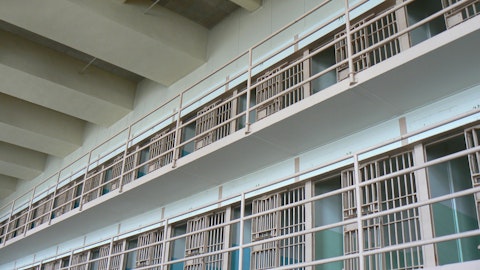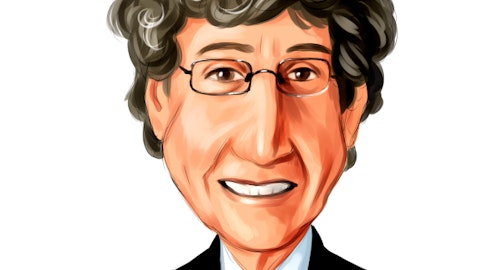Federal Signal Corporation (NYSE:FSS) Q4 2022 Earnings Call Transcript March 1, 2023
Operator: Good morning, and welcome to the Federal Signal Corporation Fourth Quarter Earnings Conference Call. . I would now like to turn the conference over to Ian Hudson, Chief Financial Officer. Please go ahead.
Ian Hudson: Good morning, and welcome to Federal Signal’s fourth quarter conference call. I’m Ian Hudson, the Company’s Chief Financial Officer. Also with me on the call today is Jennifer Sherman, our President and Chief Executive Officer. We will refer to some presentation slides today as well as to the earnings release, which we issued this morning. The slides can be followed online by going to our website, federalsignal.com, clicking on the Investor Call icon and signing into the webcast. We have also posted the slide presentation and the earnings release under the Investor tab on our website. Before I turn the call over to Jennifer, I’d like to remind you that some of our comments made today may contain forward-looking statements that are subject to the Safe Harbor language found in today’s news release and in Federal Signal’s filings with the Securities and Exchange Commission.
These documents are available on our website. Our presentation also contains some measures that are not in accordance with U.S. generally accepted accounting principles. In our earnings release and filings, we reconcile these non-GAAP measures to GAAP measures. In addition, we will file our Form 10-K later today. Jennifer is going to start today with a recap of the year, and then I will provide some more detail on our fourth quarter and full year financial results. Jennifer will then provide her perspective on our performance and go over our outlook for 2023 before we open the line for any questions. With that, I would now like to turn the call over to Jennifer.
Jennifer Sherman: Thank you, Ian. I’d like to start by giving my profound thanks to each of our employees and our business partners for their ongoing commitment to the company. As I reflect back on my tenure as CEO, I take great pride in the growth that we’ve experienced since 2016. Since then, through a combination of organic growth initiatives and M&A, our sales have doubled from a little over $700 million in 2016 to more than $1.4 billion in 2022. That represents a compound annual growth rate of around 13%. With M&A representing about 2/3 of our top line growth since 2016, acquisitions have played a key role in increasing shareholder value. We are committed to remaining disciplined in our approach to both diligence and valuation and have established a reputation as a partner of choice.
In fact, of the 11 transactions announced over this time period, 8 have been internally sourced. We have also gained traction on our key organic growth initiatives, which have helped us to further diversify our revenue streams and end market exposures and become a more resilient company. I’m also inspired by the manner in which our businesses have achieved these stellar financial results, which are outstanding, both in absolute terms and in comparison to our specialty vehicle peers while navigating through a series of complex challenges, including a global pandemic, unprecedented inflation levels and worldwide supply chain disruption. Our teams’ successful execution against our long-term financial framework and growth strategy has created meaningful value for our stockholders with our cumulative returns outpacing each of the key benchmark indices we monitor.
As I look ahead, I remain bullish about our long-term prospects and the ongoing execution of our strategy. I take encouragement from our active M&A pipeline, the additional financial flexibility provided by our increased credit facility and the fact that although we are currently performing at a high level, there is still room for further growth with the capacity we’ve added in recent years. Despite ongoing supply chain tightness in the marketplace, 2022 was a record year for Federal Signal. Our teams remained relentlessly focused on serving our customers, helping us to deliver the highest net sales and adjusted EPS in the company’s history, record orders and an improved EBITDA margin of 15% towards the high end of our target range. In addition to our strong financial performance, we also made progress against several of our long-term strategic objectives in 2022.
Within our Environmental Solutions Group, we again saw increased aftermarket demand with particular strength in rental utilization and parts and used equipment sales. Overall, our aftermarket revenues in 2022 were up 10% over last year. Demand for a range of safe-digging trucks also remained high with orders up 41% year-over-year. This growth follows investments we’ve made in facility expansions, new product development and channels for this key strategic initiative. Our investments in electrification projects continued, and we are encouraged that these efforts will provide additional opportunities to further diversify our customer base, penetrate new end markets, and gain access to new geographic regions. We made several strategic investments for the future by purchasing new machinery and equipment aimed at automating and in-sourcing production of certain components.
During 2022, we also completed the acquisition of our facility in University Park, Illinois, which is home to our domestic SSG operations and our aftermarket parts business. Our 80/20 improvement initiatives remain a critical part of our culture, and we continue to focus on reducing product costs and improving manufacturing efficiencies across all our businesses. We demonstrated our commitment to returning value to our stockholders funding a combined $38 million of cash dividends and share repurchases. To highlight our ongoing focus on operating in a socially responsible and sustainable manner, we also published our third annual sustainability report in May of ’22. I’m incredibly proud of the progress that we’ve made in our environmental, social and governance initiatives and thrilled to share many accomplishments highlighted in this report.
We measure our performance utilizing several leading ESG rating agencies, and we are pleased with the improvement in our ratings during 2022. Our ongoing commitment to the communities in which we operate is also a differentiating factor in our ability to attract talent and support strong labor relations. During 2022, the union at our Rugby, North Dakota manufacturing facility was decertified following a process that was initiated by our employees. I’ll turn the call back to Ian to go over the numbers.
Ian Hudson: Thank you, Jennifer. Our financial results for the fourth quarter and full year of 2022 are provided in today’s earnings release. Before I talk about the fourth quarter, let me highlight some of our full year consolidated results. Net sales for the year were approximately $1.43 billion, a record high for the company and an increase of $222 million or 18% compared to last year. Organic sales growth for the year was $130 million or 11%. Operating income for the year was $160.8 million, an increase of $30.1 million or 23% from last year. Adjusted EBITDA for the year was $215 million, up $34.5 million or 19% compared to last year. That translates to a margin of 15% this year, up 10 basis points from last year. GAAP earnings for the year equated to $1.97 per share, up $0.34 per share or 21% from last year.
On an adjusted basis, we reported full year earnings of $1.96 per share, up $0.21 per share or 12% from last year. Orders for the year were $1.69 billion, another company record and an increase of $153 million or 10% from last year. With the strong momentum in customer demand, consolidated backlog at the end of the year was at an all-time high level of $879 million, an increase of $250 million or 40% from last year. For the rest of my comments, I will focus mostly on comparisons of the fourth quarter of 2022 to the fourth quarter of 2021. Consolidated net sales for the quarter were $392 million, an increase of $90 million or 30% compared to last year. Organic sales growth for the quarter was $71 million or 24%. Consolidated operating income in Q4 this year was $46.6 million, up $16.5 million or 55% compared to last year.
Consolidated adjusted EBITDA for the quarter was $61.1 million, up $21.1 million or 53% compared to last year. That translates to a margin of 15.6% towards the high end of our target range and up 230 basis points from last year. GAAP EPS for the quarter was $0.57 per share, up $0.25 per share or 78% from last year. On an adjusted basis, EPS for Q4 this year was $0.57 per share, an improvement of $0.17 per share or 43% compared to last year. Orders in Q4 this year were $444 million, the second highest quarterly orders in the company’s history. In terms of our fourth quarter group results, ESG sales were $325 million, an increase of $80 million or 33% compared to last year. ESG’s adjusted EBITDA for the quarter was $57.6 million, up $21.4 million or 59% compared to last year.
That translates to an adjusted EBITDA margin of 17.7% in Q4 this year towards the high end of the Group’s target range and up 300 basis points from Q4 last year. SSG sales in Q4 this year were $66 million, up $10 million or 18% compared to Q4 last year. SSG’s adjusted EBITDA for the quarter was $13.2 million, up $2.2 million or 20% from last year. SSG’s adjusted EBITDA margin for the quarter was 19.9%, up 20 basis points from Q4 last year. Corporate operating expenses in Q4 this year were $10.2 million compared to $4.1 million in Q4 last year, which included a non-recurring $3.5 million benefit from the reduction in the fair value of contingent consideration associated with acquisition. Turning now to the consolidated statement of operations, where the increase in sales contributed to a $29.2 million improvement in gross profit.
Consolidated gross margin for the quarter was 24.7%, up 230 basis points compared to last year. As a percentage of sales, our selling, engineering, general and administrative expenses for the quarter were down 70 basis points from Q4 last year. During the fourth quarter of this year, we recognized $500,000 of expense from acquisition and integration-related activity compared to a $3 million benefit in Q4 last year, with the majority of the year-over-year change driven by the prior year contingent consideration benefit I just referenced. Other items affecting the quarterly results include a $600,000 increase in amortization expense, a $3.2 million increase in interest expense and a $700,000 increase in other expense. In Q4 last year, we also recognized non-cash pre-tax pension settlement charge of $10.3 million associated with a pension annuitization project.
Income tax expense for the quarter was $7.4 million compared to a $300,000 income tax benefit in the prior year, with the year-over-year change largely due to higher pre-tax income levels and a $1.9 million reduction in discrete tax benefits. Including discrete tax benefits, our effective tax rate for the full year of 2022 was approximately 20%. For 2023, we currently expect a tax rate of between 25% and 26%, excluding any discrete tax benefits. On an overall GAAP basis, we therefore earned $0.57 per share in Q4 this year compared with $0.32 per share in Q4 last year. To facilitate earnings comparisons, we typically adjust our GAAP earnings per share for unusual items recorded in the current or prior year quarters. In the current year quarter, we made adjustments to GAAP earnings per share to exclude acquisition-related expenses and debt settlement charges.
On this basis, our adjusted earnings in Q4 this year were $0.57 per share compared with $0.40 per share in Q4 last year. Looking now at cash flow, where we generated $40 million of cash from operations during the quarter, bringing the total amount of year-to-date operating cash generation to $72 million. Early in the fourth quarter, we executed a new 5-year $800 million credit facility, replacing the $500 million credit facility that was previously in place. During the fourth quarter, we completed the acquisition of TowHaul for an initial payment of approximately $43 million. And in early January, we completed the acquisition of Blasters for an initial payment of approximately $13 million. Our current net debt leverage ratio remains low even after factoring in recent acquisitions.
We ended the quarter with $316 million of net debt and availability under our credit facility of $428 million, with our financial position strengthened by the increased borrowing capacity under our new credit facility and our healthy cash generation, we intend to pursue additional strategic acquisitions like our recently announced Trackless deal. We also have significant financial flexibility to invest in organic growth initiatives and fund cash returns to stockholders. On that note, we paid a dividend of $0.09 per share during the fourth quarter, amounting to $5.4 million, and we recently announced a similar dividend for the first quarter. That concludes my comments, and I would now like to turn the call back to Jennifer.
Jennifer Sherman: Thank you, Ian. Overall, our fourth quarter results represented a strong finish to a record year. Within our Environmental Solutions Group increased sales volumes, contributions from recent acquisitions and strong price realization contributed to a 33% year-over-year net sales increase and 300 basis point improvement in EBITDA margin. During the fourth quarter, production and shipments at our Streator and Elgin manufacturing facilities improved by approximately 20% as compared to the third quarter. The production improvements are encouraging and demonstrate that we are benefiting from the actions taken to mitigate the global supply chain shortages, including investing in additional safety stock inventory, bringing additional suppliers online, reengineering products and in-sourcing where possible.
With its supply chain continuing to improve, our Safety and Security Systems Group also delivered impressive results during the quarter, including 18% top line growth and an EBITDA margin of approximately 20%. This performance was achieved despite a week-long plant shutdown at our University Park facility in December due to a power outage. The management team worked tirelessly to bring production back online, and I cannot express enough gratitude to the hardworking employees at our University Park facility for their efforts to partially mitigate these impacts and deliver essential equipment to customers, including working substantial overtime and on previously scheduled holidays. With its consistently strong performance over the last several quarters, at this time, we are increasing the EBITDA margin target for our Safety and Security Systems Group to a new range of 17% to 21% from the previous range of 15% to 18%.
Demand for our product offerings continues to be as strong as ever as demonstrated by our outstanding fourth quarter order intake of $444 million, contributing to another record backlog entering the year and reflecting strength across our end markets. This order strength has continued so far into 2023. I recently attended 2 large specialty vehicle trade shows, where the sentiment among our dealer network and customers remains bullish as municipalities, both small and large, are continuing to place orders at historic levels based in part by a surplus of funds directly attributed to funds provided by economic stimulus packages. In 2021, the treasury began distribution of the first $175 billion tranche that was earmarked for state, local and territorial governments for a variety of purposes, including the maintenance of essential infrastructure such as sewer systems and streets.
The second $170 billion tranche was scheduled for distribution beginning in 2022. This positive dealer sentiment is supported by the ongoing strength of U.S. municipal orders, which were up 13% year-over-year, with notably strong demand for street sweepers and sewer cleaners. In fact, in 2022, our municipal orders for street sweepers are up around $34 million or 22% over last year, while sewer cleaner orders are up $27 million or 15% over the prior year. We are also seeing strong domestic municipal demand within SSG with orders for public safety equipment up 10% year-over-year. Over the last few years, several major urban domestic municipalities had paused making investments in public safety equipment in response to the defund police movement.
This trend appears to have started to reverse. We have also seen strong demand for our public safety equipment for international markets. Turning to the $1.2 trillion Infrastructure Bill, which has $550 billion for new investments in roads, bridges, power, water and broadband infrastructure, public transportation, airports, we are beginning to see demand pick up in the form of equipment inquiries from contractors are working with state departments of transportation agencies on roads, bridges and related projects. Additionally, conversations among our dealer channel indicate contractors are now planning out projects through 2024 and are beginning to make inquiries based on their large equipment needs directly tied to these infrastructure funds.
Within our industrial end markets, we saw a 10% year-over-year improvement in domestic orders during 2022. The improvement has been almost across the board, but most notably for our TRUVAC safe digging trucks and our Guzzler industrial vacuum orders, which collectively were up $67 million or 62% year-over-year. While industrial order strength continues, we continue to experience some softness in orders for dump truck bodies as customers and dealer provided stock chassis and pool chassis for all size classes remain a primary constraint for this product offering as dump bodies typically receive lower prioritization from dealers, when chassis availability is limited based on allocations from OEMs. As chassis availability improves, we expect to see increased orders based on pent-up demand, particularly with the anticipated need for dump trucks for infrastructure-related projects.
We remain committed to our vehicle electrification initiatives and continue to identify new ways to integrate electrification into our suite of products and offer solutions to our customers on their path towards reducing their carbon footprint and improving air quality without compromising performance. We are experiencing high demand for our dealer network for demonstrations of our plug-in hybrid Broom Bear and hybrid Pelican Sweeper products. We are also excited to announce that Elgin will be introducing a full-size all-electric sweeper at the CONEXPO trade show in March. A fully electric Rugby Vari-Class platform dump body will also be featured at this trade show. We continue to incorporate recent acquisitions into our electrification roadmap and will be introducing a new Switch and Go system on a Class 4 electric chassis at the NTEA Work show next week.
With the continued advancements in electrification, we have also developed dedicated resources and partnered with industry experts to research and identify the most relevant state and federal funding information for sweepers actively linking our customers to EV funding opportunities. In addition to electrification, our innovation teams remain committed to providing solutions to solve customer problems and have launched more than 2 dozen new products in 2022. Examples include the TRUVAC TRXX series of trailer-mounted products that just launch of a 5 cubic yard version of the impact compact combination sewer cleaner and Elgin’s introduction of a non-CDL Broom Badger Street Sweeper. Jetstream also introduced its largest pump product. The 5200Q pump, which is capable of more than 700 horsepower and Ground Force launched a new 200-ton capacity belly dump coal trailer.
With a focus on features and functionality, our solutions aim to simplify ease of operation and training, reduce operating costs and maximize asset utilization. Innovation will continue to play a critical role in our long-term growth. With lead times for new equipment continuing to be extended, we expect demand for our aftermarket offerings to remain high as it was in 2022 when our aftermarket business represented 27% of ESG’s revenues. In fact, quoting activity for spring rental so far this year has been practically double what it was at the same time last year. With the combination of high rental demand and strong used equipment sales in recent quarters, we are planning to add units to our rental fleet to replenish units that were sold in 2022.
As a result, we are expecting that a larger portion of our first quarter production of Vactor, TRUVAC and Elgin units will be used to replenish our rental fleet in comparison to the prior year. We also see additional opportunities to grow our aftermarket business by expanding into new geographies, we believe to be underserved. In Colorado, for example, we have now secured a new facility, which we expect to be fully operational during the second quarter. In early January, we completed the acquisition of Blasters, a leading manufacturer of truck-mounted water blasting equipment. Blasters designs, manufactures and sells the Liquidator, and ultra-high pressure water-based road marking and rubber removal truck. Blasters also engages in the sale of certified pre-owned units and supports the recurring aftermarket needs of its customers through parts and service offerings.
The acquisition represents a strategic product line addition to Mark Rite Lines, thereby giving us the opportunity to cross launch both businesses robust market positions and allowing us to serve our shared customer base with a comprehensive range of world-class products and solutions for road and surface infrastructure maintenance. I recently attended the ATSSA’s trade show in Phoenix, where the combined MRL Blasters booth generated a lot of interest. Last week, we announced the signing of the Trackless acquisition agreement. Trackless is a leading Canadian manufacturer of multi-purpose off-road municipal tractors and a variety of attachments, which provide year-round value to its customers. The interchangeable Trackless attachments can help customers achieve carbon reduction and other environmental goals by operating a single, highly versatile unit instead of several purpose-built vehicles.
Trackless also supports the recurring aftermarket needs of its customers through a comprehensive parts offering, sales of which represent up to 20% of annual revenue. With our Joe Johnson Equipment subsidiary currently the largest distributor of Trackless products in North America, we have a great appreciation of Trackless products and a reputation for quality and innovation. We are excited about the opportunities to leverage our existing distribution channel to expand the geographic reach of Trackless products and accelerate the growth trajectory of this business. The acquisitions of Blasters and Trackless will further bolster our position as an industry-leading diversified manufacturer of specialty vehicles for maintenance and infrastructure markets.
Our deal pipeline remains active, and we continue to believe that M&A will be an important part of our growth. Turning now to our outlook, conditions in our end markets remain strong, with ongoing execution against our strategic initiatives and opportunities to drive improved efficiencies, we are confident that we will have another record year in 2023. We have started to see the benefits from federal stimulus funding in our recent order trends, contributing to a record backlog entering 2023 and improvement in supply chain. Although seasonal effects typically result in our first quarter earnings being lower than subsequent quarters, we are anticipating year-over-year growth with earnings in the first quarter of 2023 expected to represent a similar percentage of our full year outlook as in 2022.
For the full year, we are expecting net sales of between USD1.58 billion and USD1.72 billion, double-digit improvement in pre-tax earnings and EBITDA margin performance towards the upper end of our current target range. We also currently expect to report adjusted EPS of between USD2.15 and USD2.40 per share despite an aggregate year-over-year EPS headwind of approximately $0.23 per share, resulting from the normalization of our tax rate and higher interest expense. Our outlook also assumes a nominal contribution from Trackless acquisition, which we currently expect to complete during the second quarter. With an active M&A pipeline, ongoing investment in new product development, recently completed capacity expansions, good access to skilled labor and anticipated multi-year tailwinds from infrastructure legislation and economic stimulus, our businesses are well positioned for long-term sustainable growth.
With that, we are ready to open the lines for questions. Operator?
See also 25 Best Countries for a Comfortable Retirement and 12 Stocks to Sell According to Motley Fool .
Q&A Session
Follow Federal Signal Corp (NYSE:FSS)
Follow Federal Signal Corp (NYSE:FSS)
Operator: . Our first question is from Mike Shlisky with D.A. Davidson.
Michael Shlisky: I guess, the first question is probably the one you pin down to answer once the Q&A starts. The most obvious one is, I’m glad you raised one segment’s margin targets. What kept you from raising the other one, what should we be watching for in ’23 to hopefully make that second jump there?
Jennifer Sherman: Yes. As we talked about last year, we saw supply chain started to improve in our SSG segment earlier than the supply chain improvement started traction in our ESG segment. So we want to make sure when we increase these margin targets that we’re going to hit the targets. And so although we’re encouraged by the supply chain improvement we saw in Q4 for ESG will still need — we need — still need some time to make sure that, that’s going to stick. And supply chain improvement has not been linear in our world. We have good days and bad days. And the good news is, we’re having more good days than bad days. But we go a little bit forward, a little bit sideways, a little bit backwards and we move towards the top. So it’s really driven by the improvement — the sustainable improvement that we’ve seen in supply chain where SSG predated ESG. But we’re watching it carefully, and we’re committed to increase them.
Michael Shlisky: Great. I didn’t hear much commentary this quarter around chassis supply. I’m just curious, is there a reason, was it just things are kind of best normal for you? Or it’s just not something that’s been as much of a focus as it had in the past couple of quarters?
Jennifer Sherman: Yes. So let me start with TBI. Chassis supply is still a problem. In terms of prioritization for our TBI customers, we don’t own the chassis in that situation. So typically, we’re lower in the queue, and it is a constraint right now. Based on the public comments made by some of the chassis OEMs, we’re hopeful as we get to the second half of the year that we’re going to see improvement. On our non-TBEI vehicle businesses, we’re still on allocation, but we’ve gotten better at allocation. We’ve been able to go out and procure some additional chassis. Our dealers have been able to procure chassis. Some of our customers have been able to procure chassis. Would we like more chassis, absolutely, but we’ve done a pretty good job of maneuvering our way through this. And again, we’re hopeful that we see more chassis availability in the second half of the year, but we don’t control that.
Ian Hudson: Yes. And I think, Mike, just to build on Jennifer’s point, obviously, the — having — we’ve made a strategic decision to provide more chassis. When you look at our inventory on a year-over-year basis, about $13 million of that increase is because we’ve invested in chassis. And we’re doing that really to try and serve our customers, but it’s come with a headwind to our gross margin. In Q4, for example, but it was a headwind of about 70 basis points of our gross margin was because we supplied more chassis. So I think that is something that, overtime, we would like to go back to kind of more steady state. But given the environment we’re operating in, we’ve made the decision to provide more chassis than we typically would.
Michael Shlisky: Great. I want to throw one more and then perhaps a 2-part question on the Trackless deal. Can you share — does that company use an off-the-shelf engine or a large company brand engine in their machines and an opportunity to get any purchasing synergies there with other businesses like your street sweepers, et cetera? And the other part of the question is, I noticed, is that an industrial mowing business maintenance. That’s not been a focus on Federal Signal in the past in my knowledge, nothing tremendous. Are you looking to expand more into the green parts of the infrastructure going forward?






